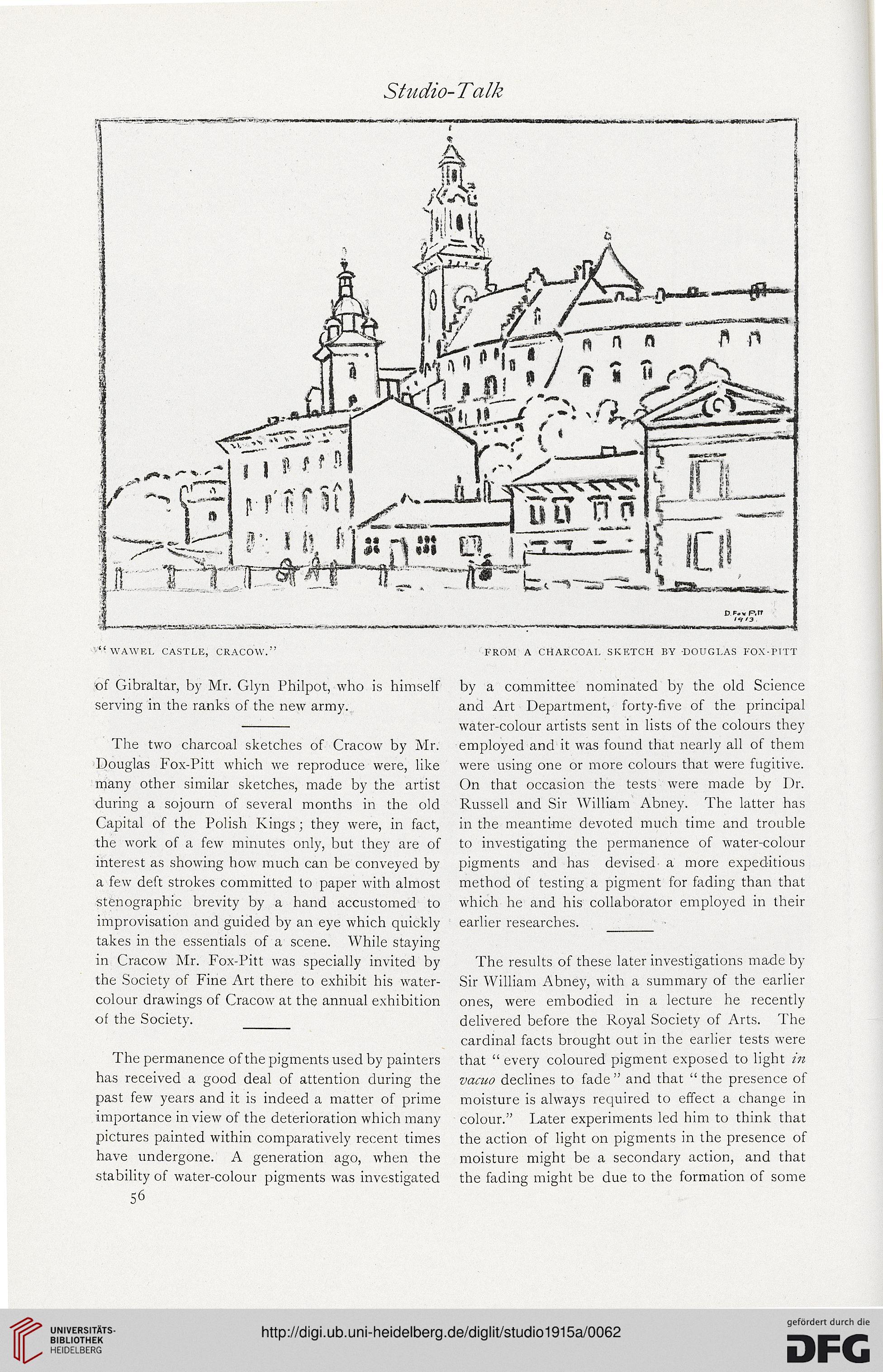Studio-Talk
!
“ WAWEL CASTLE, CRACOW.”
FROM A CHARCOAL SKETCH BY -DOUGLAS FOX-PITT
of Gibraltar, by Mr. Glyn Philpot, who is himself
serving in the ranks of the new army.
The two charcoal sketches of Cracow by Mr.
Douglas Fox-Pitt which we reproduce were, like
many other similar sketches, made by the artist
during a sojourn of several months in the old
Capital of the Polish Kings; they were, in fact,
the work of a few minutes only, but they are of
interest as showing how much can be conveyed by
a few deft strokes committed to paper with almost
stenographic brevity by a hand accustomed to
improvisation and guided by an eye which quickly
takes in the essentials of a scene. While staying
in Cracow Mr. Fox-Pitt was specially invited by
the Society of Fine Art there to exhibit his water-
colour drawings of Cracow at the annual exhibition
of the Society. _
The permanence of the pigments used by painters
has received a good deal of attention during the
past few years and it is indeed a matter of prime
importance in view of the deterioration which many
pictures painted within comparatively recent times
have undergone. A generation ago, when the
stability of water-colour pigments was investigated
56
by a committee nominated by the old Science
and Art Department, forty-five of the principal
water-colour artists sent in lists of the colours they
employed and it was found that nearly all of them
were using one or more colours that were fugitive.
On that occasion the tests were made by Dr.
Russell and Sir William Abney. The latter has
in the meantime devoted much time and trouble
to investigating the permanence of water-colour
pigments and has devised a more expeditious
method of testing a pigment for fading than that
which he and his collaborator employed in their
earlier researches.
The results of these later investigations made by
Sir William Abney, with a summary of the earlier
ones, were embodied in a lecture he recently
delivered before the Royal Society of Arts. The
cardinal facts brought out in the earlier tests were
that “ every coloured pigment exposed to light in
vacuo declines to fade ” and that “ the presence of
moisture is always required to effect a change in
colour.” Later experiments led him to think that
the action of light on pigments in the presence of
moisture might be a secondary action, and that
the fading might be due to the formation of some
!
“ WAWEL CASTLE, CRACOW.”
FROM A CHARCOAL SKETCH BY -DOUGLAS FOX-PITT
of Gibraltar, by Mr. Glyn Philpot, who is himself
serving in the ranks of the new army.
The two charcoal sketches of Cracow by Mr.
Douglas Fox-Pitt which we reproduce were, like
many other similar sketches, made by the artist
during a sojourn of several months in the old
Capital of the Polish Kings; they were, in fact,
the work of a few minutes only, but they are of
interest as showing how much can be conveyed by
a few deft strokes committed to paper with almost
stenographic brevity by a hand accustomed to
improvisation and guided by an eye which quickly
takes in the essentials of a scene. While staying
in Cracow Mr. Fox-Pitt was specially invited by
the Society of Fine Art there to exhibit his water-
colour drawings of Cracow at the annual exhibition
of the Society. _
The permanence of the pigments used by painters
has received a good deal of attention during the
past few years and it is indeed a matter of prime
importance in view of the deterioration which many
pictures painted within comparatively recent times
have undergone. A generation ago, when the
stability of water-colour pigments was investigated
56
by a committee nominated by the old Science
and Art Department, forty-five of the principal
water-colour artists sent in lists of the colours they
employed and it was found that nearly all of them
were using one or more colours that were fugitive.
On that occasion the tests were made by Dr.
Russell and Sir William Abney. The latter has
in the meantime devoted much time and trouble
to investigating the permanence of water-colour
pigments and has devised a more expeditious
method of testing a pigment for fading than that
which he and his collaborator employed in their
earlier researches.
The results of these later investigations made by
Sir William Abney, with a summary of the earlier
ones, were embodied in a lecture he recently
delivered before the Royal Society of Arts. The
cardinal facts brought out in the earlier tests were
that “ every coloured pigment exposed to light in
vacuo declines to fade ” and that “ the presence of
moisture is always required to effect a change in
colour.” Later experiments led him to think that
the action of light on pigments in the presence of
moisture might be a secondary action, and that
the fading might be due to the formation of some




